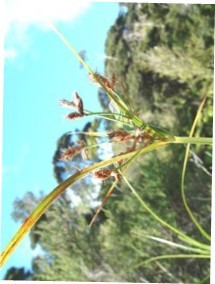River bulrush
(Bolboschoenus fluviatilis)

Description
Bolboschoenus fluviatilis (Synonyms: Scirpus fluviatilis), the river bulrush, is a species of flowering plant in the sedge family, Cyperaceae. Its range includes Australia, New Zealand, New Caledonia, Canada, the United States, and northeastern Mexico. B. fluviatilis and its fruits are important as food sources for waterfowl such as geese, ducks, bitterns, and swans. It also provides cover and nesting sites for these and other species of birds, as well as small mammals. Like other Bolboschoenus species, B. fluviatilis has strong tubers and rhizomes which help to stabilize intertidal habitats by preventing erosion. River bulrush can be found in fresh water or brackish water marshes, and in the quiet waters of streams and lakes. It has been shown to propagate and flourish in a wide variety of water depths, but produces the most biomass in shallowly flooded conditions. B. fluviatilis, and other bulrush species, are threatened by pollution, habitat destruction, and competition from invasive plant species such as Typha angustifolia and Phragmites australis in the Hudson Valley. Scirpus is a genus of grass-like species in the sedge family Cyperaceae many with the common names club-rush, wood club-rush or bulrush (see also bulrush for other plant genera so-named). They mostly inhabit wetlands and damp locations. Scirpus are rhizomatous perennial herbs, with 3-angled stems and flat grass-like leaves. The flowers are in clusters of small spikelets, often brown or greenish brown. Some species (e.g. S. lacustris) can reach a height of 3 m, while S. sylvaticus is about 1.2 m and others, such as S. supinus, are much smaller, only reaching 20–30 cm tall. The genus has a nearly cosmopolitan distribution, found on every continent except Africa and Antarctica. The taxonomy of the genus is complex, and under review by botanists. Recent studies by taxonomists of the Cyperaceae have resulted in the creation of several new genera, including the genera Schoenoplectus and Bolboschoenus; others (including Blysmus, Isolepis, Nomochloa, and Scirpoides) have also been used. At one point this genus held almost 300 species, but many of the species once assigned to it have now been reassigned, and it now holds an estimated 120 species.
Taxonomic tree:







